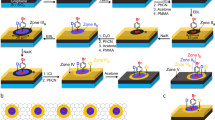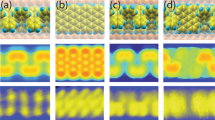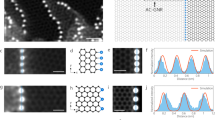Abstract
Although fullerenes can be efficiently generated from graphite in high yield, the route to the formation of these symmetrical and aesthetically pleasing carbon cages from a flat graphene sheet remains a mystery. The most widely accepted mechanisms postulate that the graphene structure dissociates to very small clusters of carbon atoms such as C2, which subsequently coalesce to form fullerene cages through a series of intermediates. In this Article, aberration-corrected transmission electron microscopy directly visualizes, in real time, a process of fullerene formation from a graphene sheet. Quantum chemical modelling explains four critical steps in a top-down mechanism of fullerene formation: (i) loss of carbon atoms at the edge of graphene, leading to (ii) the formation of pentagons, which (iii) triggers the curving of graphene into a bowl-shaped structure and which (iv) subsequently zips up its open edges to form a closed fullerene structure.
This is a preview of subscription content, access via your institution
Access options
Subscribe to this journal
Receive 12 print issues and online access
$259.00 per year
only $21.58 per issue
Buy this article
- Purchase on Springer Link
- Instant access to full article PDF
Prices may be subject to local taxes which are calculated during checkout


Similar content being viewed by others
References
Smalley, R. E. Self-assembly of the fullerenes. Acc. Chem. Res. 25, 98–105 (1992).
Goroff, N. S. Mechanism of fullerene formation. Acc. Chem. Res. 29, 77–83 (1996).
Kroto, H. W. & McKay, K. The formation of quasi-icosahedral spiral shell carbon particles. Nature 331, 328–331 (1988).
Heath, J. R. Synthesis of C60 from small carbon clusters: a model based on experiment and theory. ACS Symp. Ser. 481, 1–23 (1991).
Hunter, J. M., Fye, J. F., Roskamp, E. J. & Jarrold, M. F. Annealing carbon cluster ions—a mechanism for fullerene synthesis. J. Phys. Chem. 98, 1810–1818 (1992).
Rubin, Y., Kahr, M., Knobler, C. B., Diederich, F. & Wilkins, C. L. The higher oxides of carbon C8nO2n (n=3–5): synthesis, characterization and X-ray crystal structure. Formation of cyclo[n]carbon ions Cn+ (n=18, 24), Cn− (n=18, 24, 30), and higher carbon ions including C60+ in laser desorption Fourier transform mass spectrometric experiments. J. Am. Chem. Soc. 113, 495–500 (1991).
Irle, S., Zheng, G., Wang, Z. & Morokuma, K. The C60 formation puzzle ‘solved’: QM/MD simulations reveal the shrinking hot giant road of the dynamic fullerene self-assembly mechanism. J. Chem. Phys. B 110, 14531–14545 (2006).
Huang, J. Y., Ding, F., Jiao, K. & Yakobson, B. I. Real time microscopy, kinetics and mechanism of giant fullerene evaporation. Phys. Rev. Lett. 99, 175503 (2007).
Yannoni, C. S., Bernier, P. P., Bethune, D. S., Meijer, G. & Salem, J. R. NMR determination of the bond lengths in C60 . J. Am. Chem. Soc. 113, 3190–3192 (1991).
Hawkins, J. M., Meyer, A., Loren, S. & Nunlist, R. Statistical incorporation of carbon-13 13C2 units into C60 (buckminsterfullerene). J. Am. Chem. Soc. 113, 9394–9395 (1991).
Ebbesen, T. W., Tabuchi, J. & Tanigaki, K. The mechanistics of fullerene formation. Chem. Phys. Lett. 191, 336–338 (1992).
Geim, A. K. & Novoselov, K. S. The rise of graphene. Nature Mater. 6, 183–191 (2007).
Girifalco, L. A. & Hodak, M. Van der Waals binding energies in graphitic structures. Phys. Rev. B 65, 125404 (2002).
Ulbricht, H., Moos, G. & Hertel, T. Interaction of C60 with carbon nanotubes and graphite. Phys. Rev. Lett. 90, 095501 (2003).
El-Barbary, A. A., Telling, R. H., Ewels, C. P., Heggie, M. I. & Briddon, P. R. Structure and energetics of the vacancy in graphite. Phys. Rev. B 68, 144107 (2003).
Saito, M., Yamashita, K. & Oda, T. Magic numbers of graphene multivacancies. Jpn J. Appl. Phys. 46, L1185–L1187 (2007).
Carlsson, J. M. & Scheffler, M. Structural, electronic and chemical properties of nanoporous carbon. Phys. Rev. Lett. 96, 046806 (2006).
Girit, C. O. et al. Graphene at the edge: stability and dynamics. Science 323, 1705–1708 (2009).
Jia, X. et al. Controlled formation of sharp zigzag and armchair edges in graphitic nanoribbons. Science 323, 1701–1705 (2009).
Lozovik, Y. E. & Popov, A. M. Formation and growth of carbon nanostructures: fullerenes, nanoparticles, nanotubes and cones. Uspekhi Fizicheskikh Nauk 167, 751–774 (1997).
Eggen, B. R. et al. Autocatalysis during fullerene growth. Science 272, 87–90 (1996).
Ioffe, I. N. et al. Fusing pentagons in a fullerene cage by chlorination: IPR D2C76 rearranges into non-IPR C76Cl24 . Angew. Chem. Int. Ed. 48, 5904–5907 (2009).
Ugarte, D. Curling and closure of graphitic networks under electron-beam irradiation. Nature 359, 707–709 (1992).
Burden, A. P. & Hutchison, J. L. An investigation of the electron irradiation of graphite in a helium atmosphere using a modified electron microscope. Carbon 35, 567–578 (1997).
Füller, T. & Banhart, F. In situ observation of the formation and stability of single fullerene molecules under electron irradiation. Chem. Phys. Lett. 254, 372–378 (1996).
Otero, G. et al. Fullerenes from aromatic precursors by surface-catalysed cyclodehydrogenation. Nature 454, 865–868 (2008).
Bunshah, R. F. et al. Fullerene formation in sputtering and electron beam evaporation processes. J. Phys. Chem. 96, 6866–6869 (1992).
Xie, Z.-X. et al. Formation and coalescence of fullerene ions from direct laser vaporization. J. Chem. Soc. Faraday Trans. 91, 987–990 (1995).
Scherzer, O. The theoretical resolution limit of the electron microscope. J. Appl. Phys. 20, 20–29 (1949).
Chuvilin, A. & Kaiser, U. On the peculiarities of CBED pattern formation revealed by multislice simulation. Ultramicroscopy 104, 73–82 (2005).
Shao, Y. et al. Advances in methods and algorithms in a modern quantum chemistry program package. Phys. Chem. Chem. Phys. 8, 3172–3191 (2006).
Becke, A. D. A new mixing of Hartree–Fock and local density-functional theories. J. Chem. Phys. 98, 1372–1377 (1993).
Acknowledgements
This work was supported by the Engineering and Physical Sciences Research Council (Career Acceleration Fellowship to E.B., grant no. EP/C545273/1 to A.N.K.), the European Science Foundation, the Royal Society, the DFG (German Research Foundation) and the State Baden-Württemberg within the SALVE (Sub Angström Low Voltage Electron Microscopy) project and by the DFG within Collaborative Research Centre (SFB) 569.
Author information
Authors and Affiliations
Contributions
A.C. conceived, designed and carried out experiments. U.K. contributed to the development of the experimental methodology and the discussion of the results. E.B. and N.A.B. performed theoretical modelling and contributed equally to this work. A.N.K. proposed the mechanism and wrote the original manuscript. All authors discussed the results and commented on the manuscript.
Corresponding authors
Ethics declarations
Competing interests
The authors declare no competing financial interests.
Supplementary information
Supplementary information
Supplementary information (PDF 403 kb)
Supplementary information
Supplementary Movie S1 (AVI 9094 kb)
Rights and permissions
About this article
Cite this article
Chuvilin, A., Kaiser, U., Bichoutskaia, E. et al. Direct transformation of graphene to fullerene. Nature Chem 2, 450–453 (2010). https://doi.org/10.1038/nchem.644
Received:
Accepted:
Published:
Issue Date:
DOI: https://doi.org/10.1038/nchem.644
This article is cited by
-
Graphene quantum dots as game-changers in solar cell technology: a review of synthetic processes and performance enhancement
Carbon Letters (2024)
-
Time-resolved imaging and analysis of the electron beam-induced formation of an open-cage metallo-azafullerene
Nature Chemistry (2023)
-
Gas phase synthesis of the C40 nano bowl C40H10
Nature Communications (2023)
-
Interstellar Carbonaceous Dust and Its Formation Pathways: From an Experimental Astrochemistry Perspective
Journal of the Indian Institute of Science (2023)
-
Synthesis and Growth of Onion-Like Polyhedral Graphitic Nanocapsules by Thermal Plasma
Plasma Chemistry and Plasma Processing (2023)



